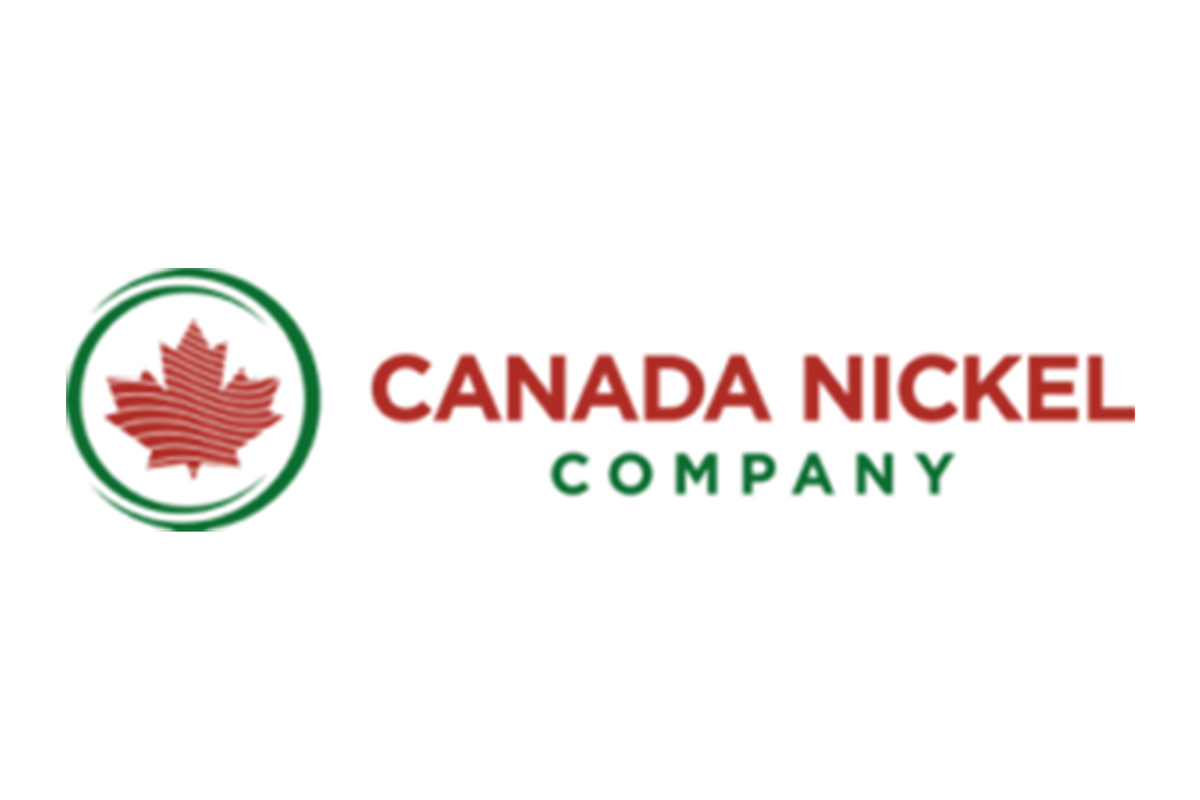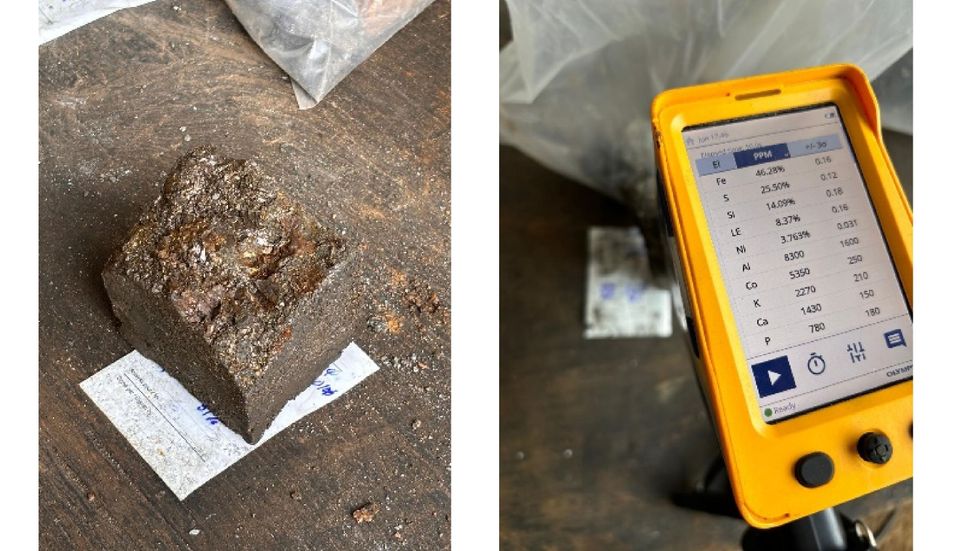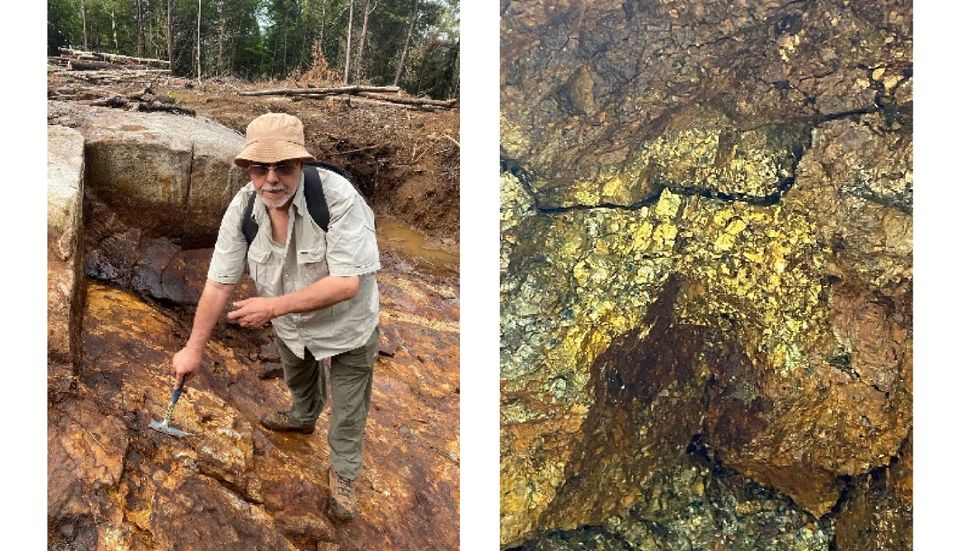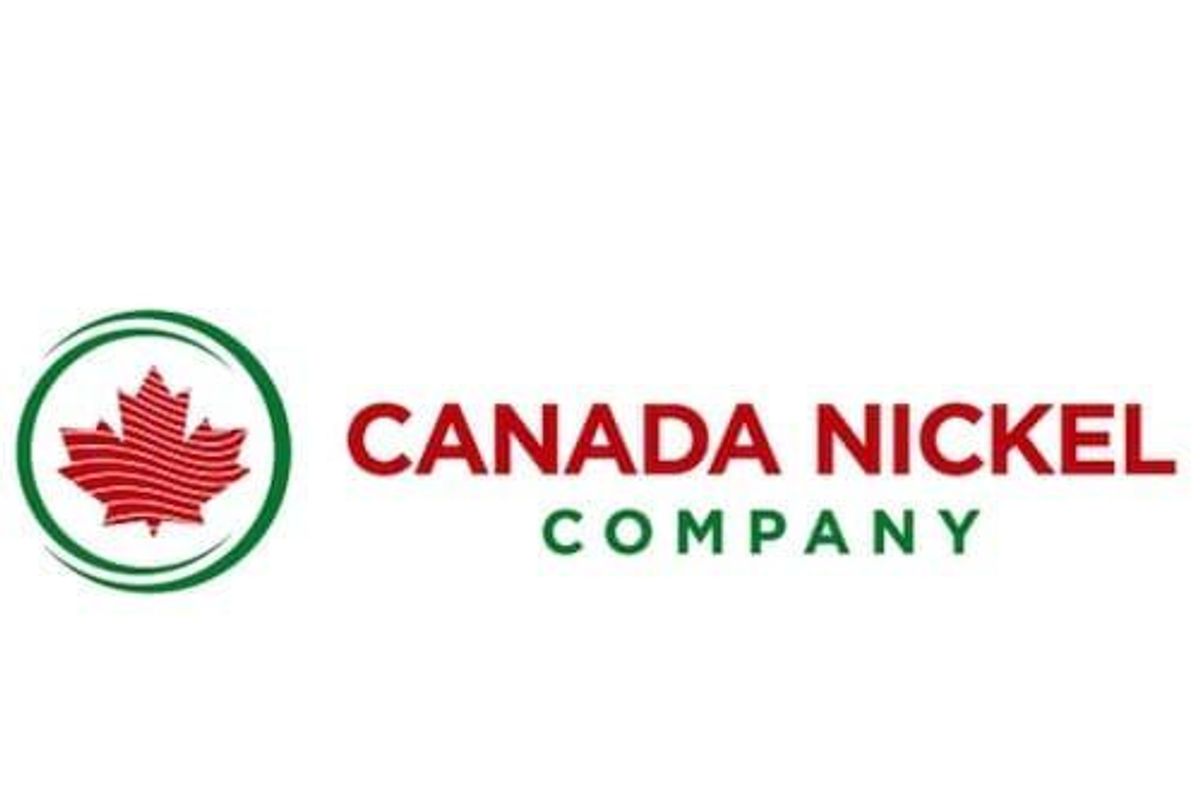
Highlights
- $1.2 billion after-tax NPV 8% and 16% after-tax IRR
- First quartile net C1 cash cost of $1.09 /lb and net AISC of $1.94 /lb of nickel
- Production of 1.9 billion pounds nickel over 25 years
- Annual EBITDA of $439 million and annual free cash flow of $274 million
- Immediately advancing to feasibility study
(All amounts in US dollars unless otherwise indicated.)
Canada Nickel Company Inc. ("Canada Nickel" or the "Company") (TSXV: CNC) (OTCQB: CNIKF), is pleased to announce that the Preliminary Economic Assessment ("PEA") has confirmed robust economics showing an after-tax NPV 8% of $1.2 billion and an after-tax IRR of 16% from its wholly owned flagship Crawford Nickel Sulphide Project ("Crawford") located in Timmins, Ontario, Canada . The PEA, prepared by Ausenco Engineering Canada Inc. ("Ausenco") in accordance with National Instrument 43-101 ("NI 43-101"), demonstrates the potential to develop a phased conventional nickel sulphide concentrator, producing nickel concentrates and magnetite concentrate. The operation is designed to have an open pit mine with a plant potential of 120,000 tonnes per day.
The Company is immediately advancing the project to a feasibility study, which is expected to be completed by mid-2022.
"We are focused on delivering the next generation of nickel and are pleased that this PEA demonstrates the robust economics of our flagship Crawford project. The PEA, utilizing just a fraction of our resource potential, demonstrates that we expect to be one of the largest nickel sulphide operations globally, producing 1.9 billion pounds of nickel over a 25-year period with net cash costs of just over $1 per pound. Our current focus on the stainless steel market allows us to fully utilize the substantial by-product value for the contained iron and chrome, placing us on the lower end of the cost curve. I am very proud of our team for delivering these results in just over 20 months since our first drill holes and I look forward to continuing to unlock the district scale nickel potential of the Timmins region," said Mark Selby , Chairman and CEO of Canada Nickel.
Mr. Selby further stated, "The PEA is a milestone that enables a whole range of key activities as we aggressively advance the project towards production by the middle part of the decade. We are immediately embarking on a feasibility study. We are calculating our carbon footprint and evaluating Crawford's potential to deliver NetZero Nickel TM , NetZero Cobalt TM and NetZero Iron TM . We are exploring opportunities to deliver the nickel in our concentrates into the electric vehicle ("EV") market. We have begun our Environmental and Social Impact Assessment ("ESIA"), and we continue to work in partnership with Indigenous and local communities. We intend to implement an extensive and inclusive stakeholders' consultation process that will allow us to identify and mitigate the project impacts in order to deliver sustainable benefits for multiple generations."
Crawford 2021 PEA Highlights
- Robust economics
- After-tax, $1.2 billion NPV 8% and 16% IRR at long-term price assumptions 1
- Large scale, low cost, long-life
- Annual average nickel production of 75 million pounds (34,000 tonnes) with peak period annual average of 93 million pounds (42,000 tonnes)
- Significant iron and chrome by-products of 860,000 tonnes per annum and 59,000 tonnes per annum, respectively
- Life- of-mine net C1 cash cost of $1.09 /lb and net AISC of $1.94 /lb on a by-product basis (1 st quartile 2 )
- Life-of-mine production of 25 years with 842,000 tonnes of nickel, 21 million tonnes of iron and 1.5 million tonnes of chrome valued at $24 billion using long-term price assumptions. 1
- Significant earnings and free cash flow generation
- Annual EBITDA of $439 million and free cash flow of $274 million .
- Minimization of carbon footprint
- Use of autonomous trolley trucks and electric shovels reduce diesel use by 40%
- Optimization of the carbon sequestration potential of the tailings and waste rock.
The PEA is preliminary in nature, it includes inferred mineral resources that are considered too speculative geologically to have the economic considerations applied to them that would enable them to be categorized as mineral reserves, and there is no certainty that the results of the PEA will be realized.
| _______________________ | |
| 1 | Refer to Note on assumptions below |
| 2 | Source – as per figure above (Crawford's Net C1 Cash Cost vs 2020 Net C1 Cash Cost of Global Nickel Operations) |
Crawford PEA Summary
| | Unit | Phase I | Phase II | Phase III | Life-Of-Mine | ||||
| Mining & Milling | | | | | | | | | |
| Mill Capacity | ktpd | 42.5 | 85 | 120 | | | |||
| Ore Mined | ktpd (Mtpa) | 71 | (26) | 95 | (35) | 125 | (46) | 100 | (37) |
| Ore Milled | ktpd (Mtpa) | 40 | (15) | 83 | (30) | 119 | (44) | 100 | (37) |
| Strip Ratio | | 1.34 | 1.90 | 2.20 | 2.08 | ||||
| Grade | | | | | | | | | |
| Nickel | % | 0.32 | 0.26 | 0.25 | 0.25 | ||||
| Chromium | % | 0.62 | 0.63 | 0.58 | 0.60 | ||||
| Iron | % | 6.02 | 6.46 | 6.58 | 6.51 | ||||
| Recovery | | | | | | | | | |
| Nickel | % | 50 | 44 | 39 | 37 | ||||
| Chromium | % | 27 | 27 | 27 | 27 | ||||
| Iron | % | 38 | 32 | 36 | 36 | ||||
| Annual Production | | | | | | | | | |
| Nickel | Mlbs (kt) pa | 52 | (23) | 77 | (35) | 93 | (42) | 75 | (34) |
| Chromium | ktpa | 25 | 52 | 69 | 59 | ||||
| Iron | ktpa | 335 | 630 | 1,023 | 860 | ||||
| Revenue & Costs | | | | | | | | | |
| NSR | US$/t milled | $31.09 | $23.93 | $21.49 | $20.86 | ||||
| | | | | | | | |||
| Mining | US$/t milled | $5.25 | $3.97 | $4.22 | $3.84 | ||||
| Milling | US$/t milled | $4.77 | $4.54 | $4.11 | $4.19 | ||||
| G&A | US$/t milled | $0.98 | $0.51 | $0.38 | $0.42 | ||||
| Total Onsite Costs | US$/t milled | $11.00 | $9.02 | $8.71 | $8.45 | ||||
| | | | | | | | | | |
| Net C1 | US$/lb Ni | $1.46 | $1.32 | $1.20 | $1.09 | ||||
| Cash Cost | US$/t Ni | $3,218 | $2,905 | $2,640 | $2,400 | ||||
| | | | | | | | | | |
| Net AISC | US$/lb Ni | $3.09 | $2.57 | $1.97 | $1.94 | ||||
| | US$/t Ni | $6,808 | $5,656 | $4,335 | $4,284 | ||||
| | | | | | | | | | |
| C1 Cash Cost Before | US$/lb Ni | $3.44 | $3.89 | $4.47 | $4.54 | ||||
| By-product Credits | US$/t Ni | $7,591 | $8,577 | $9,857 | $10,008 | ||||
| | | | | | | | | | |
| Cash Flow | | | | | | | | | |
| Annual EBITDA | US$ millions | $287 | $437 | $538 | $439 | ||||
| Annual Free Cash Flow | US$ millions | $39 | $244 | $368 | $274 | ||||
Note on assumptions
- The Company utilized metal price assumptions from third party sources applying a nickel price of $7.75 /lb, a chromium price of $1.04 /lb and an iron price of $290 per tonne (based on U.S. benchmark iron scrap price). In addition, a US$/C$ exchange rate of $0.75 and oil price of US$60 /barrel were also applied.
- Further details on production can be found on the Company's website at www.canadanickel.com
- Revenue & Costs information and Cash Flow data are non-IFRS measures. Refer to Non-IFRS measures .
Additional Opportunities
There remains significant potential for additional value to be created at the Crawford project through a number of identified opportunities, which include:
- Significant additional exploration potential within the Crawford project and at the Company's additional properties including the Company's most recent acquisition at Bradburn/Dargavel
- Optimization of nickel, iron, chrome recovery and concentrate grades through additional testwork during feasibility study stage
- Determination of the carbon capture potential from the carbon sequestration potential of the Company's tailings and waste rock to permit the Company to achieve net zero carbon footprint operation production of NetZero Nickel TM , NetZero Cobalt TM and NetZero Iron TM products
- Processing of nickel concentrates to capture cobalt, platinum group metals ("PGM") content through various processing alternatives for the company's high grade and standard grade concentrates and deliver nickel and cobalt to EV market
- Capital cost reductions via electricity distribution and fleet acquisition opportunities through the Company's Memorandum of Understanding with Taykwa Tagamou First Nation to participate in the financing of all or a portion of the project's electricity supply and heavy mining equipment fleet required for Crawford's operation
- Completion of negotiations to potentially utilize Glencore's Kidd Creek mill based on the capital and operating costs successfully determined during the initial phase of work.
Crawford Overview
The Crawford project will be a conventional open pit mine/mill operation powered by zero-carbon electricity and utilizing trolley trucks and electric rope shovels to minimize its carbon footprint through reduced diesel consumption. The project will produce three products: (1) a high-grade concentrate estimated at 35% nickel; (2) a standard grade concentrate estimated at 12% nickel; and (3) a magnetite concentrate estimated at 48% iron and 3% chromium. All of the products are assumed to be sold based on the nickel, iron, and chromium content of the concentrates on terms which provide sufficient incentive for the construction of a co-located stainless steel mill using the same RKEF-AOD approach utilized very successfully in China and Indonesia. The Company's wholly-owned subsidiary NetZero Metals Inc. will begin negotiations with potential partners immediately following the release of the PEA.
The process plant will utilize a conventional milling operation consisting of crushing, grinding, desliming and flotation operations consistent with other ultramafic nickel operations. The process plant will be constructed in three phases. Phase I will have a steady-state throughput of 42,500 tonnes per day using a single 36 x 24 foot semi-autonomous grinding mill and a 26.5 x 44 foot ball mill grinding circuit. Phase II will double throughput starting in year four, by mirroring the first line. Phase III will raise production to the ultimate rate of 120,000 tonnes per day through the addition of secondary crushing and a third ball mill and additional downstream capacity.
Location & Infrastructure
The Crawford project lies within the Abitibi upland physiographic region and has a typical "Laurentian Shield" landscape. The Crawford project is located in Crawford and Lucas townships, about 42 kilometres north of the city of Timmins in the heart of the prolific Timmins - Cochrane mining camp in Ontario, Canada , and is adjacent to well-established, major infrastructure associated with over 100 years of regional mining activity. The Crawford project is located adjacent to a paved highway, a power line with sufficient capacity for the construction period, with other major power lines and rail access located nearby.
Mining
The Crawford project is currently comprised of two separate open pits. The mine production plan includes 37% of the overall mill feed from inferred resources. Mining will commence in the Main Zone, which represents approximately 77% of the total mineralized material. Over 90% of the material mined will be rock, which will be drilled and blasted before being loaded by 700 tonne class electrically powered hydraulic excavators into 290 tonne autonomous trucks that will use trolley assist on uphill hauls. The remaining material will be overburden, which will not require drilling and blasting and will be loaded and hauled with a mixed fleet including 45 tonne, 90 tonne and 290 tonne trucks. Mining of the East Zone will commence after the Main Zone is depleted in year 17 and will continue through year 25. A key element of the mine plan is the de-coupling of mine production rates for the Main Zone from that of the plant. This allows for accelerated output of metal in the early years from higher grade and recovery material, while lower grade and recovery material is stockpiled and used to supplement feed from the East Zone in later years. This strategy also allows tailings produced from the second half of year 17 onwards to be impounded within the mined-out Main Zone, significantly reducing the size and associated cost of the Tailings Storage Facility.
Inclusion of the trolley assist option is a major driver in reducing greenhouse gas (GHG) emission, noise level, fleet size and overall project environmental footprint.
Mineral Processing
The concentrator and associated infrastructure facilities will process run-of-mine or stockpiled material using a conventional milling process. Unit steps in the flowsheet include: crushing, semi-autogenous and ball mill grinding, desliming, nickel flotation as well as magnetic separation of the flotation tails. The concentrator will produce three product streams: high grade nickel concentrate (35% nickel), standard nickel concentrate (12% nickel) and a magnetite concentrate that contains approximately 48% iron and 3% chromium. Nickel, iron and chromium are three key alloying metals in the production of stainless steel, which makes Canada Nickel products suitable feeds for this market and increases the value of the product per tonne of nickel due to the stainless steel pricing and premiums available in the United States and European markets.
Based on analysis by CRU, utilization of scoping study work completed by Kingston Process Metallurgy Inc. (KPM) and Steel and Metals Market Research (SMR), the Company should be able to achieve 91% payability for contained nickel, 71% payability for contained iron, and 43% payability for contained chromium in its feeds and provide sufficient incentive for the construction of a local stainless steel mill which would also produce additional nickel pig iron products based on the nickel/iron mix of the feeds.
At this time, the Company is not receiving any value for the contained cobalt and PGM content in its nickel concentrates as the Company has chosen a stainless steel path which currently provides the most value to the Company and can reliably be processed into conventional products utilizing existing, proven technology. With rapidly increasing demand from the EV market, we will consider these processing options if they provide additional value for the Company's project output. Discussions with various supply chain participants in the EV supply chain are expected to accelerate now with the completion of the PEA.
Capital Cost Estimate
| US$ millions | | Initial 42.5 ktpd | 85 ktpd | 120 ktpd | | Life-Of-Mine |
| Initial and Expansion | | | | | | |
| Mining | | 201 | - | - | | 201 |
| Process plant | | 294 | 294 | 98 | | 685 |
| Site and services | 157 | 132 | 4 | | 293 | |
| Infrastructure | | 149 | 15 | 25 | | 189 |
| Indirects | | 108 | 31 | 22 | | 161 |
| Owners' costs | | 29 | - | - | | 29 |
| Contingency | | 250 | 71 | 45 | | 366 |
| | | 1,188 | 543 | 194 | | 1,925 |
| | | Pre-production | Phase I | Phase II | Phase III | Life-Of-Mine |
| Sustaining and closure | | | | | | |
| Mining | | - | 187 | 195 | 285 | 711 |
| Site and services | - | 34 | 44 | 136 | 214 | |
| Infrastructure | | - | 8 | 15 | 91 | 132 |
| Closure | | 26 | 9 | - | - | 34 |
| | | 26 | 238 | 254 | 512 | 1,091 |
| | | | | | | |
| Total | | 1,213 | 781 | 448 | 512 | 3,016 |
The total capital estimate includes the direct field cost for executing the project, the contractor's costs for construction management, the indirect costs of construction, the owner's indirect costs associated with design, construction and commissioning, as well as the cost of the owner-provided mining fleet and internal costs for preproduction development, including stockpiled inventory. The capital does not include escalation, interest, or working capital. Working capital has been included in the economic analysis.
The PEA is preliminary in nature and as such an average contingency of 25% was applied to both initial and expansion capital expenditures.
Operating Cost Estimate
| | Phase I | Phase II | Phase III | Life-Of-Mine | ||||
| Operating costs/tonne milled | US$ | C$ | US$ | C$ | US$ | C$ | US$ | C$ |
| Labour | 2.39 | 3.19 | 1.49 | 1.98 | 1.20 | 1.60 | 1.26 | 1.68 |
| Consumables | 2.49 | 3.31 | 2.36 | 3.14 | 2.30 | 3.07 | 2.25 | 3.00 |
| Maintenance | 1.70 | 2.27 | 1.47 | 1.96 | 1.69 | 2.25 | 1.54 | 2.05 |
| Diesel | 1.02 | 1.36 | 0.78 | 1.04 | 0.78 | 1.04 | 0.72 | 0.96 |
| Power | 2.45 | 3.26 | 2.40 | 3.20 | 2.35 | 3.13 | 2.25 | 3.00 |
| Other | 0.95 | 1.27 | 0.52 | 0.70 | 0.40 | 0.53 | 0.43 | 0.58 |
| | 11.00 | 14.66 | 9.02 | 12.02 | 8.72 | 11.62 | 8.45 | 11.27 |
Operating costs were developed using a zero based model calibrated against the actual results of peer operations. Labour costs include the benefits of the use of productivity improving technologies such as autonomous trucks and drills while diesel costs will be minimized through the use of trolley-assisted haulage.
Sensitivities
| | | Delta NPV8% ($ millions) | | Delta IRR (%) | | Delta Net C1 Cash Cost ($/lb) | |||
| Sensitivity | | - | + | | - | + | | - | + |
| Nickel Price ±$1/lb ($6.75/lb - $8.75/lb) | | (445) | 435 | | (2.8) | 2.6 | | n.a. | n.a. |
| Nickel Price ±10% ($6.98/lb - $8.53/lb ) | | (342) | 341 | | (2.1) | 2.0 | | n.a. | n.a. |
| Iron Price ±10% ($261/tonne - $319/tonne) | (101) | 101 | | (0.6) | 0.5 | | 0.26 | (0.26) | |
| Oil Price ±$10/bbl ($50/bbl - $70/bbl) | | 20 | (20) | | 0.1 | (0.1) | | (0.04) | 0.03 |
| Exchange Rate ±$0.05 ($0.70 - $0.80) | | 222 | (226) | | 1.8 | (1.7) | | (0.29) | 0.28 |
| Nickel Recovery ±10% | | (344) | 339 | | (2.2) | 2.0 | | 0.12 | (0.10) |
| Initial Capex ±10% | | 83 | (84) | | 1.1 | (1.0) | | n.a. | n.a. |
| Expansion Capex ±10% | | 36 | (36) | | 0.3 | (0.3) | | n.a. | n.a. |
| Operating Costs ±10% | | 101 | (101) | | 0.6 | (0.6) | | (0.23) | 0.23 |
Sensitivity analysis does not reflect changes in underlying cost with changes in metal prices.
Next Steps
With the successful completion of the Crawford PEA, Canada Nickel is immediately initiating a feasibility study with a timeline for a mid-year 2022 release. The Company has started work on its ESIA which is a key step in its permitting process which the company will aggressively advance alongside the work on the feasibility study. The Company will also continue to explore its additional nickel properties in addition to Crawford.
The technical report in support of the PEA will be filed under Canada Nickel's profile on SEDAR at www.sedar.com within 45 days of the date of this press release.
Mineral Resource Estimate
| | | Tonnage | | Grade | | Contained Metal | |||||||||||
| | | Mt | | % Ni | % Fe | %Cr | % Co | %S | g/t Pd | g/t Pt | | kt Ni | Mt Fe | kt Cr | kt Co | koz Pd | koz Pt |
| Main Higher Grade Zone | | | | | | | | | | | | | | | | | |
| Measured | | 151.7 | | 0.32% | 6.25% | 0.60% | 0.013% | 0.20% | 0.029 | 0.012 | | 482.2 | 9.5 | 910.2 | 19.9 | 140.6 | 56.7 |
| Indicated | | 128.6 | | 0.30% | 6.37% | 0.57% | 0.013% | 0.16% | 0.027 | 0.013 | | 391.8 | 8.2 | 738.1 | 16.5 | 111.1 | 51.7 |
| M&I | | 280.2 | | 0.31% | 6.31% | 0.59% | 0.013% | 0.18% | 0.028 | 0.012 | | 873.9 | 17.7 | 1,648.3 | 36.4 | 251.7 | 108.4 |
| Inferred | | 109.9 | | 0.29% | 6.66% | 0.58% | 0.013% | 0.09% | 0.026 | 0.013 | | 315.0 | 7.3 | 641.8 | 14.0 | 92.9 | 46.7 |
| Main Lower Grade Zone | | | | | | | | | | | | | | | | | |
| Measured | | 62.5 | | 0.22% | 6.83% | 0.61% | 0.013% | 0.05% | -- | -- | | 135.1 | 4.3 | 383.5 | 8.2 | -- | -- |
| Indicated | | 263.2 | | 0.21% | 6.90% | 0.60% | 0.013% | 0.04% | -- | -- | | 557.0 | 18.2 | 1,591.1 | 34.6 | -- | -- |
| M&I | | 325.6 | | 0.21% | 6.89% | 0.61% | 0.013% | 0.04% | -- | -- | | 692.1 | 22.4 | 1,974.6 | 42.9 | -- | -- |
| Inferred | | 210.2 | | 0.21% | 6.87% | | 0.013% | 0.06% | -- | -- | | 444.9 | 14.4 | 1,289.2 | 27.1 | -- | -- |
| East Zone | | | | | | | | | | | | | | | | | |
| Measured | | 25.8 | | 0.26% | 6.03% | 0.63% | 0.012% | 0.04% | -- | -- | | 67.4 | 1.6 | 161.8 | 3.2 | -- | -- |
| Indicated | | 21.8 | | 0.26% | 6.20% | 0.65% | 0.013% | 0.04% | -- | -- | | 56.2 | 1.4 | 141.6 | 2.7 | -- | -- |
| M&I | | 47.6 | | 0.26% | 6.11% | 0.64% | 0.013% | 0.04% | -- | -- | | 123.6 | 2.9 | 303.4 | 6.0 | -- | -- |
| Inferred | | 177.1 | | 0.24% | 6.63% | 0.63% | 0.013% | 0.04% | -- | -- | | 424.1 | 11.7 | 1,113.3 | 22.7 | -- | -- |
| Total Crawford Resources | | | | | | | | | | | | | | | | | |
| M&I | | 653.5 | | 0.26% | 6.58% | 0.60% | 0.013% | 0.10% | 0.028 | 0.012 | | 1,689.8 | 43.0 | 3,926.3 | 85.2 | 251.7 | 108.4 |
| Inferred | | 497.2 | | 0.24% | 6.74% | 0.61% | 0.013% | 0.06% | 0.026 | 0.013 | | 1,184.0 | 33.5 | 3,044.3 | 63.9 | 92.9 | 46.7 |
| 1. | The independent Qualified Person for the Mineral Resource Estimate, as defined by NI 43-101, is Dr. Scott Jobin-Bevans (P.Geo., APGO #0183), of Caracle Creek International Consulting Inc. The effective date of the Mineral Resource Estimate is May 21, 2021. |
| 2. | These Mineral Resources are not Mineral Reserves as they do not have demonstrated economic viability. The quantity and grade of reported Inferred Resources in this Mineral Resource Estimate are uncertain in nature and there has been insufficient exploration to define these Inferred Resources as Indicated or Measured. However, it is reasonably expected that the majority of Inferred Mineral Resources could be upgraded to Indicated Mineral Resources with continued exploration. |
| 3. | A cut-off grade of 0.15% Ni was used for the low-grade domains (Main and East zones) and cut-off grades of 0.25% Ni (Main Zone) and 0.21% Ni (East Zone) were used for the high-grade domains. Cut-offs were determined on the basis of core assay geostatistics and drill core lithologies for the deposit, and by comparison to analogous deposit types. |
| 4. | Geological and block models for the Mineral Resource Estimate used data from a total of 62 surface drill holes (51 in the Main Zone and 11 in the East Zone), completed by Spruce Ridge Resources (4 holes in 2018) and Noble Mineral Exploration and Canada Nickel Company (58 holes in 2019-2020). The drill hole database was validated prior to resource estimation and QA/QC checks were made using industry-standard control charts for blanks, core duplicates and commercial certified reference material inserted into assay batches by Canada Nickel, and by comparison of umpire assays performed at a second laboratory. |
| 5. | Estimates have been rounded to two significant figures. |
| 6. | The mineral resource estimates have also been revised in the Amended Technical Report to include a conceptual pit envelope constraint that was developed using the optimization parameters included in the Amended Technical Report. Metal prices used (US$) were $7.75/lb nickel, $15/lb cobalt, $90/tonne magnetite, $1.04/lb chromium, $1,600/oz Pd, and $800/oz Pt. Different pit slopes were used for each layer (in degrees): 9.5 in clay, 21.8 in gravel and 45 in rock. Exchange rate utilized was US$/C$ of $0.75. Mining costs utilized different values for overburden (clay, gravel), selective mining and bulk mining ranging from C$1.75 to C$3.15/t mined. Processing costs and G&A for 100ktpd operation were C$6.18/t. Based on the range of grade and ratio of sulphur to nickel at Crawford, recovery could be expected to range from 10% - 60%. It has also been assumed that 30 – 40% of total iron would be recovered to a saleable magnetite concentrate. |
| 7. | The Mineral Resource Estimate was prepared following the CIM Estimation of Mineral Resources & Mineral Reserves Best Practice Guidelines (November 29, 2019). |
| MAIN ZONE: | |
| 8. | The geological model as applied to the Mineral Resource Estimate for the Main Zone comprises three mineralized domains hosted by variably serpentinized ultramafic rocks: a relatively high-grade core (largely dunite) and two northern and southern lower grade envelopes (combination of dunite and peridotite). Individual wireframes were created for each domain. |
| 9. | The block model was prepared using Micromine 2020. A 12 m x 12 m x 9 m block model was created and samples were composited at 4.5 m intervals. Grade estimation from drill hole data was carried out for Ni, Co, Fe, Cr, S using the Ordinary Kriging interpolation method and Pd and Pt using the Inverse Distance Squared method. |
| 10. | Grade estimation was validated by comparison of input and output statistics (Nearest Neighbour and Inverse Distance Squared methods), swath plot analysis, and by visual inspection of the assay data, block model, and grade shells in cross-sections. |
| 11. | Density estimation was carried out for the mineralized domains using the Ordinary Kriging interpolation method, on the basis of 3,270 specific gravity measurements collected during the core logging process, using the same block model parameters of the grade estimation. As a reference, the average estimated density value within the high-grade is 2.64 g/cm3 (t/m3), while low-grade domains of the resource model yielded averages of 2.63 g/cm3 (t/m3) in the north and 2.71 g/cm3 (t/m3) in the south. |
| EAST ZONE: | |
| 12. | The geological model as applied to the Mineral Resource Estimate for the East Zone comprises three mineralized domains hosted by variably serpentinized ultramafic rocks: a relatively high-grade core (largely dunite) and two northern and southern lower grade envelopes (largely peridotite). Individual wireframes were created for each domain. |
| 13. | The block model was prepared using Micromine 2020. A 20 m x 20 m x 15 m block model was created and samples were composited at 3 m intervals. Grade estimation from drill hole data was carried out for Ni, Co, Fe, Cr and S using the Inverse Distance Squared method. |
| 14. | Grade estimation was validated by comparison of input and output statistics (Nearest Neighbor method), swath plot analysis, and by visual inspection of the assay data, block model, and grade shells in cross-sections. |
| 15. | An average bulk density value for each mineralized domain was calculated on the basis of 244 specific gravity measurements collected during the core logging process. Blocks within the high-grade were assigned a single bulk density value of 2.62 g/cm3 (t/m3), while low-grade domains of the resource model were assigned single bulk density values of 2.66 g/cm3 (t/m3) in the north and 2.72 g/cm3 (t/m3) in the south. |
Conference Call Details
Canada Nickel is hosting a live Q&A conference call on May 26, 2021 at 10:00 a.m. EDT . Participants may join the call as follows:
Dialing local Toronto : +1-416-764-8688
Dialing North American Toll Free: +1-888-390-0546
Dialing International Toll Free: available upon request
Webcast URL: https://produceredition.webcasts.com/starthere.jsp?ei=1463704&tp_key=c92241d65a
Confirmation #: 10317274
A playback version will be available for one month after the call at +1-416-764-8677 (local or international) or
North American toll free at +1-888-390-0541 (passcode 317274 #).
About Canada Nickel
Canada Nickel Company Inc. is advancing the next generation of nickel-cobalt sulphide projects to deliver nickel and cobalt required to feed the high growth electric vehicle and stainless steel markets. Canada Nickel Company has applied in multiple jurisdictions to trademark the terms NetZero Nickel TM , NetZero Cobalt TM , NetZero Iron TM and is pursuing the development of processes to allow the production of net zero carbon nickel, cobalt, and iron products. Canada Nickel provides investors with leverage to nickel and cobalt in low political risk jurisdictions. Canada Nickel is currently anchored by its 100% owned flagship Crawford Nickel-Cobalt Sulphide Project in the heart of the prolific Timmins - Cochrane mining camp.
Additional Notes
Qualified Persons and NI 43-101 Compliance
Stephen J. Balch P.Geo . (ON), VP Exploration of Canada Nickel and a "qualified person" as such term is defined by National Instrument 43-101, has verified the data disclosed in this news release, and has otherwise reviewed and approved the technical information in this news release on behalf of Canada Nickel.
Non-IFRS Measures
The Company has included certain non-IFRS measures in this press release. The Company believes that these measures provide investors an improved ability to evaluate the underlying performance of the project. The non-IFRS measures are intended to provide additional information and should not be considered in isolation or as a substitute for measures of performance prepared in accordance with IFRS. These measures do not have any standardized meaning prescribed under IFRS, and therefore may not be comparable to other issuers.
Net C1 cash costs are the sum of operating costs (including all expenses related to stripping), net of by-product credits from chromium and iron ore per pound of payable nickel. Net AISC (all in sustaining costs) are C1 cash costs plus royalties plus sustaining capital per pound of payable nickel. Sustaining and expansion capital are non-IFRS measures. Sustaining capital is defined as capital required to maintain operations at existing levels. Expansion capital is defined as capital expenditures for major growth projects or enhancement capital for significant infrastructure improvements at existing operations. Both measurements are used by management to assess the effectiveness of investment programs.
NSR (Net Smelter Return) includes gross revenues less refining costs. EBITDA is earnings before interest, taxes and depreciation, which comprise NSR less royalties and operating costs and for the purpose of the economic analysis assume all stripping costs are expensed. Free cash flow represents operating cash flow less capital expenditures.
Cautionary Statement Concerning Forward-Looking Statements
This press release contains certain information that may constitute "forward-looking information" under applicable Canadian securities legislation. Forward looking information includes, but is not limited to, the results of Crawford's PEA, including statements relating to net present value, future production, estimates of cash cost, proposed mining plans and methods, mine life estimates, cash flow forecasts, metal recoveries, estimates of capital and operating costs, timing for permitting and environmental assessments, realization of mineral resource estimates, capital and operating cost estimates, project and life of mine estimates, ability to obtain permitting by the time targeted, size and ranking of project upon achieving production, economic return estimates, the timing and amount of estimated future production and capital, operating and exploration expenditures and potential upside and alternatives. Readers should not place undue reliance on forward-looking statements.
Forward-looking statements involve known and unknown risks, uncertainties and other factors which may cause the actual results, performance or achievements of Canada Nickel to be materially different from any future results, performance or achievements expressed or implied by the forward-looking statements. The PEA results are estimates only and are based on a number of assumptions, any of which, if incorrect, could materially change the projected outcome. There are no assurances that Crawford will be placed into production. Factors that could affect the outcome include, among others: the actual results of development activities; project delays; inability to raise the funds necessary to complete development; general business, economic, competitive, political and social uncertainties; future prices of metals or project costs could differ substantially and make any commercialization uneconomic; availability of alternative nickel sources or substitutes; actual nickel recovery; conclusions of economic evaluations; changes in project parameters as plans continue to be refined;
accidents, labour disputes, the availability and productivity of skilled labour and other risks of the mining industry; political instability, terrorism, insurrection or war; delays in obtaining governmental approvals, necessary permitting or in the completion of development or construction activities; mineral resource estimates relating to Crawford could prove to be inaccurate for any reason whatsoever; additional but currently unforeseen work may be required to advance to the feasibility stage; and even if Crawford goes into production, there is no assurance that operations will be profitable.
Although Canada Nickel has attempted to identify important factors that could cause actual actions, events or results to differ materially from those described in forward-looking statements, there may be other factors that cause actions, events or results to differ from those anticipated, estimated or intended. Forward-looking statements contained herein are made as of the date of this news release and Canada Nickel disclaims any obligation to update any forward-looking statements, whether as a result of new information, future events or results or otherwise, except as required by applicable securities laws.
PEA Engineering
The PEA was completed by Ausenco, a global leader in engineering and project management services for the resource and energy sectors. Ausenco was chosen for the PEA because of its expertise and experience with similar sized, large scale base metal projects and proven experience with processing of ultramafic nickel deposits. Ausenco has successfully designed and constructed similar sized concentrators such as Mina Justa (16.5 ktpd) for Macobre S.A.C, Lumwana concentrator (55 ktpd) for Equinox Minerals, the Phu Kham concentrator (33 ktpd) for PanAust, the GDP3 expansion (30 ktpd concentrator) of the Gibraltar Mine for Taseko and the $1.75 billion Constancia project for Hudbay Minerals (80 ktpd concentrator). The PEA team also included Caracle Creek (resource model, geotechnical), David Penswick (mine design and financial modeling) and Wood Plc. (TSF, environmental).
![]() View original content to download multimedia: https://www.prnewswire.com/news-releases/canada-nickel-preliminary-economic-assessment-confirms-robust-economics-of-crawford-nickel-sulphide-project-301298453.html
View original content to download multimedia: https://www.prnewswire.com/news-releases/canada-nickel-preliminary-economic-assessment-confirms-robust-economics-of-crawford-nickel-sulphide-project-301298453.html
SOURCE Canada Nickel Company Inc.

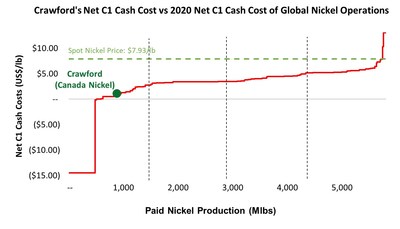

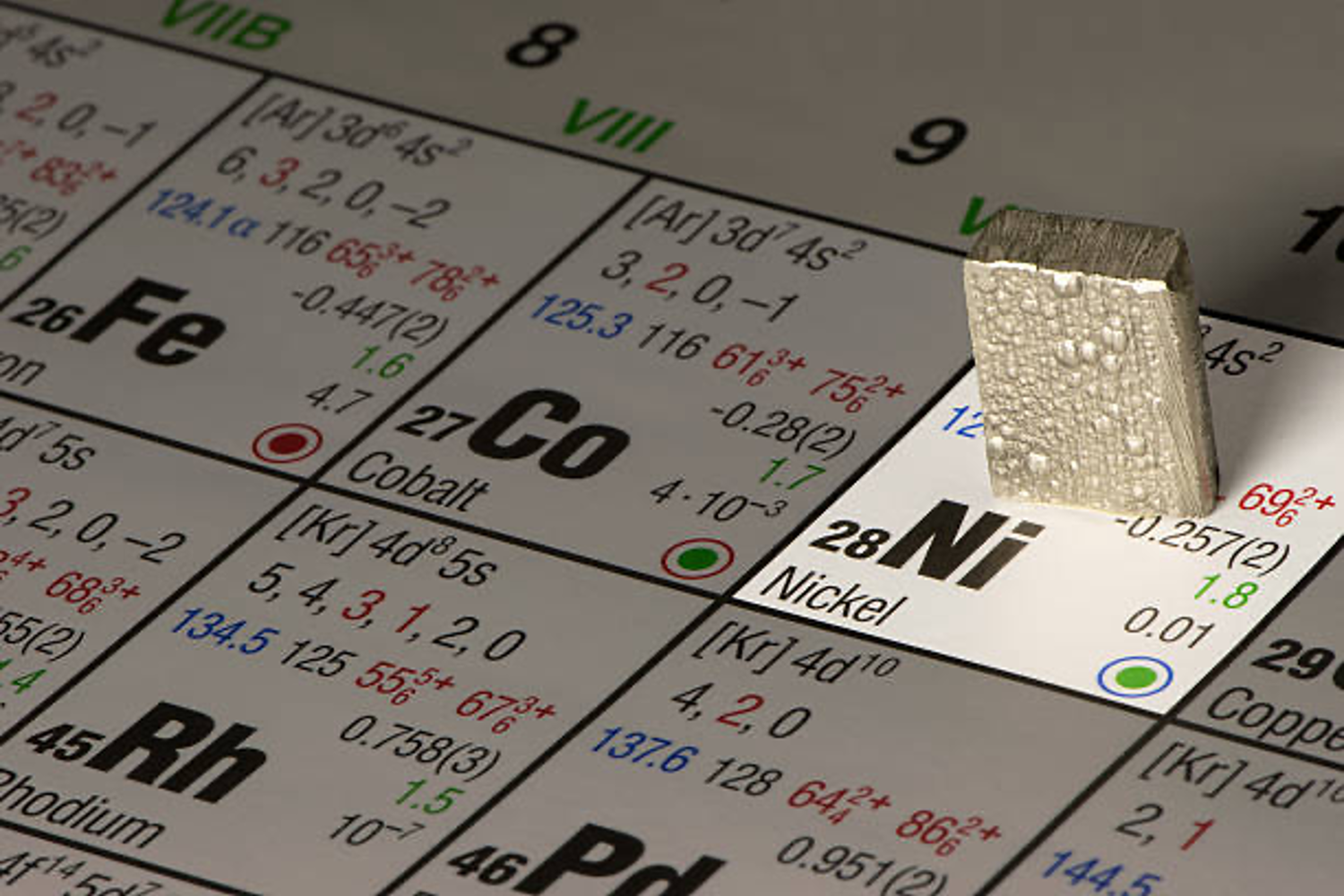

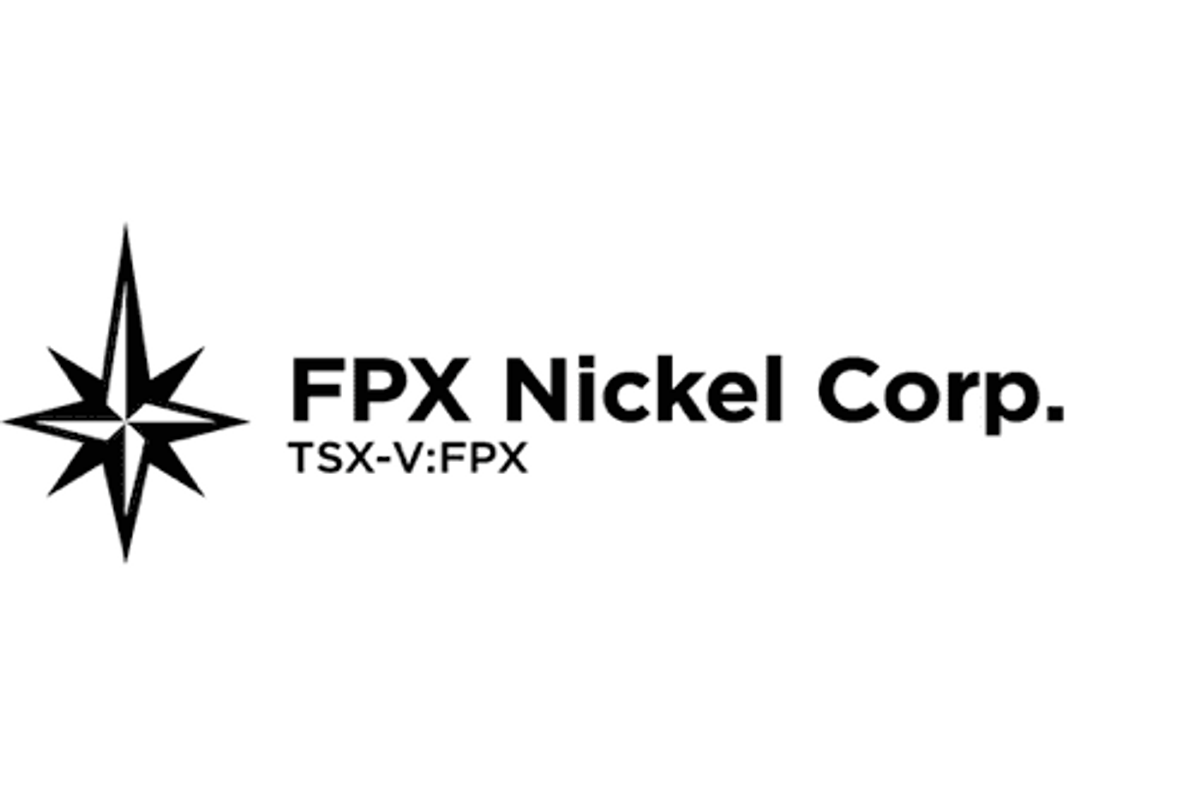
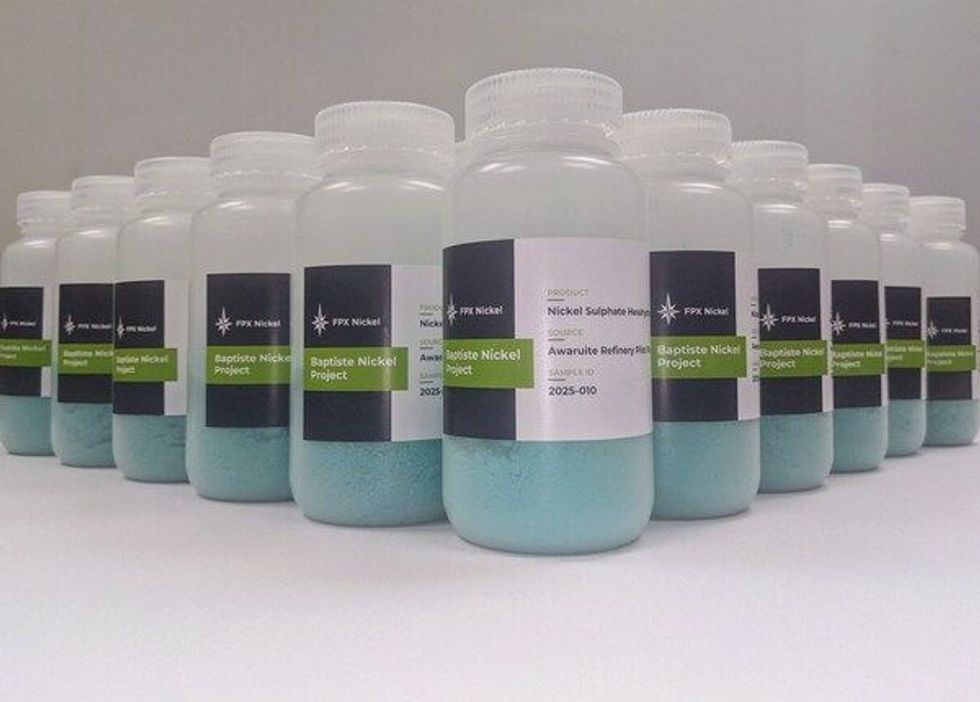
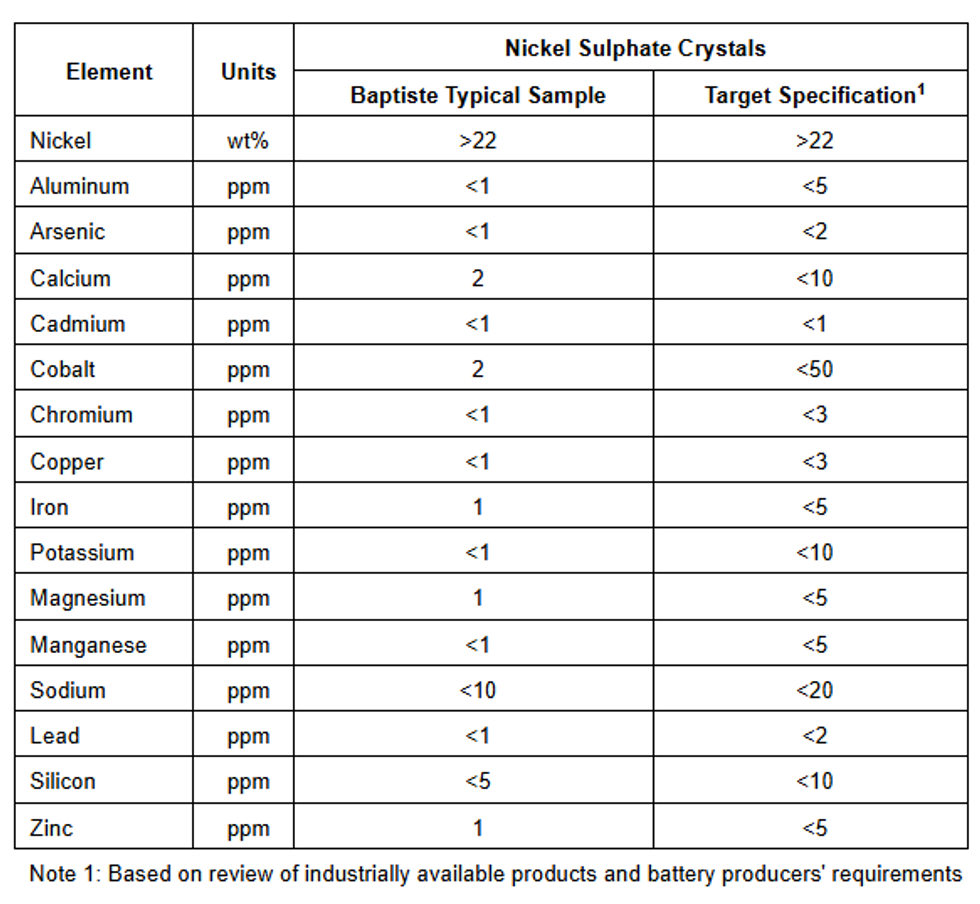 Table 2 – Baptiste Nickel Sulphate Crystal Quality vs. Target Specification
Table 2 – Baptiste Nickel Sulphate Crystal Quality vs. Target Specification